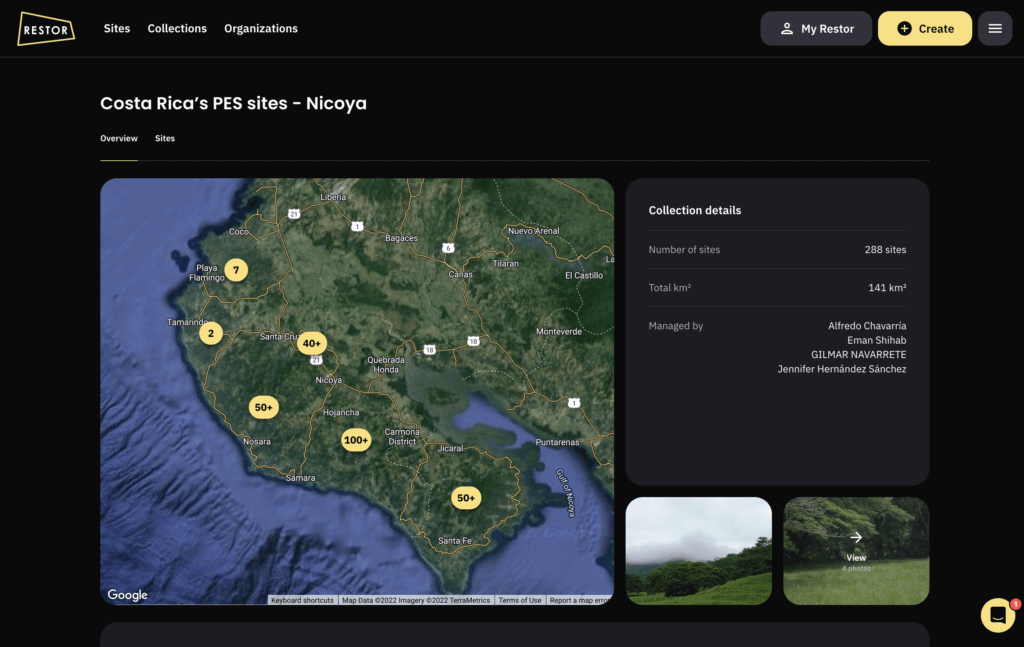- At COP27, Costa Rica sends a message to the world, we can’t achieve the Paris Agreement without nature.
- To accelerate investment in Nature-based Solutions, it is essential to bring transparency to the benefits they offer to people, biodiversity, and the climate.
- Today, Costa Rica has published its Payment for Environmental Services program sites and embarks on an innovative evaluation of biodiversity.
In March, Costa Rica signed a partnership agreement with Restor and Crowther Lab at ETH Zurich focused on bringing transparency to their globally recognized Payment for Environmental Services (PES) program, managed by the Ministry for Environment and Energy (MINAE) through the National Forest Financing Fund (Fonafifo) of Costa Rica. Since then, the parties have been working together to upload nearly 2,000 sites that participated in the program between 2018 and 2021 to the Restor platform. Today, Costa Rica published the first 288 of these sites, the first country to do so. In taking this step, Costa Rica hopes to inspire others to do the same. They also hope to raise awareness about the impact of the program and the critical importance of scaling it up in the coming years.
In taking this step, Costa Rica hopes to inspire others to do the same. They also hope to raise awareness about the impact of the program and the critical importance of scaling it up in the coming years.
“There’s an urgency to scale up this program in order to reach Costa Rica’s — and the world’s — net zero commitments. By demonstrating what Payment for Environmental Services can do for people, biodiversity, and our climate, we invite more countries, and government and business leaders to join us,” explains Franz Tattenbach, Minister for Environment and Energy, Costa Rica.
“Clearly, there is huge potential to scale up the Payment for Environmental Services program, in Costa Rica and beyond,” continues Clara Rowe, CEO of Restor. “Our hope is that more actors will put nature first and transparently share the impacts of their restoration and conservation initiatives.”
Measuring impact
Through PES, landowners receive direct payments for the environmental services that their lands produce when adopting sustainable land use and forest-management techniques. The positive socio-economic impact of Costa Rica’s PES program has been well documented. And the program has played a key role in forest recovery: since 1996, Costa Rica has doubled the size of its forest, becoming the first tropical country to reverse deforestation. However, measuring biodiversity impact has been more complicated.
In the first nationwide study of its kind, Crowther Lab is using measurements of bioacoustics to quantify biodiversity. In its pilot phase, this study is focused on the Province of Guanacaste, in the canton of Nicoya. Led by Giacomo Delgado and Prof. Thomas Crowther, this research will scale to the other six provinces, thereby using Costa Rica’s soundscape to quantify the biodiversity protected and restored by the PES program.
The first bioacoustic measurements can now be heard on Restor and the work will be presented at two Nature Zone events during COP27 in Egypt, “Monitoring biocomplexity for Costa Rica’s nature market” and “Transparency: the key to accelerating global nature restoration.”
On the impact of this research, Prof. Dr. Thomas Crowther says, “Scientific evidence for the successful regeneration of biodiversity is a research challenge at any scale, but this is particularly exciting as the first quantitative evaluation of a successful biodiversity intervention nationally.”

